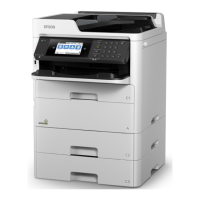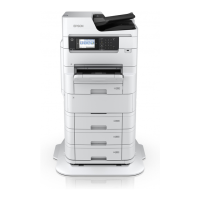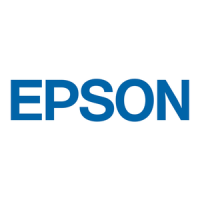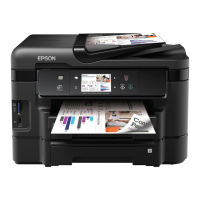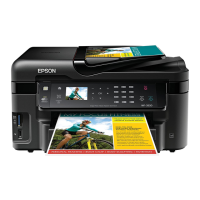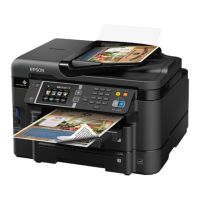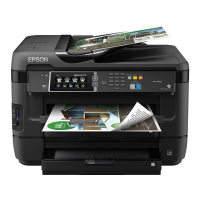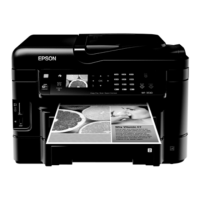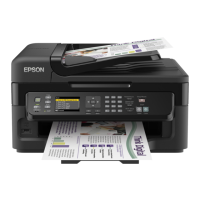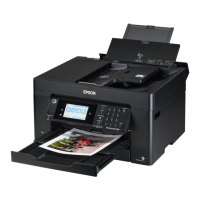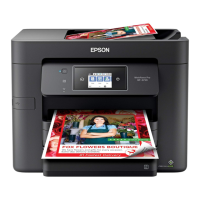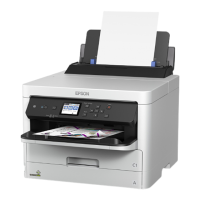
Do you have a question about the Epson WorkForce Pro WF-C5290 and is the answer not in the manual?
| Color | Yes |
|---|---|
| Printing colors | Black, Cyan, Magenta, Yellow |
| Maximum duty cycle | 5000 pages per month |
| Number of print cartridges | 4 |
| Page description languages | - |
| Maximum resolution | 4800 x 1200 DPI |
| Time to first page (black, normal) | - s |
| Print speed (color, draft quality, A4/US Letter) | 34 ppm |
| Print speed (black, normal quality, A4/US Letter) | 24 ppm |
| Card reader integrated | No |
| Sound pressure level (printing) | 55 dB |
| Total input capacity | 830 sheets |
| Total output capacity | - sheets |
| Total number of input trays | 1 |
| Maximum number of input trays | 2 |
| Product color | White |
| Market positioning | Home & office |
| Power consumption (printing) | - W |
| Storage temperature (T-T) | -20 - 40 °C |
| Operating temperature (T-T) | 10 - 35 °C |
| Storage relative humidity (H-H) | 5 - 85 % |
| Operating relative humidity (H-H) | 20 - 80 % |
| Server operating systems supported | Windows Server 2003, Windows Server 2003 R2, Windows Server 2008, Windows Server 2008 R2, Windows Server 2012, Windows Server 2012 R2 |
| Sustainability certificates | ENERGY STAR |
| Depth | 578 mm |
|---|---|
| Width | 425 mm |
| Height | 449 mm |
Learn to navigate and use the printer's control panel and its settings.
Identify the different physical parts and components of the printer.
Configure settings for automatic sleep mode and power-off functions.
Utilize Epson Connect services for printing from various mobile devices.
Print wirelessly from Apple devices like iPhone, iPad, and Mac.
Print from any device with a Google account using Google Cloud Print.
Print from Android devices using the Mopria Print Service.
Enable wireless printing from Android devices using the Epson Print Enabler.
Print wirelessly from Amazon Fire tablets and phones.
Print wirelessly from Windows 10 Mobile tablets and phones.
Connect and print using NFC from your Android device.
Steps to protect your printer and network from unauthorized access.
Configure the printer to connect to a wireless network via a router.
Configure wireless network settings directly on the printer's control panel.
Connect devices directly to the printer without a router using Wi-Fi Direct.
Connect to a WPS-enabled network quickly and easily.
Print a sheet detailing network settings to diagnose connection issues.
Update or modify existing network connection settings for the printer.
Manage printer network settings via a web browser interface.
Switch the printer's connection from USB to Wi-Fi.
Switch the printer's connection from Wi-Fi to a wired Ethernet connection.
Update the printer's Wi-Fi connection when changing your router.
Turn off the printer's Wi-Fi capabilities if needed.
Install the Universal Print Driver for Windows to support multiple printer languages.
Install PostScript (PS3) printer software for Windows for advanced printing.
Install PostScript (PS3) printer software for Mac for advanced printing.
Configure settings for PCL and PostScript printing via the control panel.
Customize PDL settings for PCL or PostScript printing.
Configure the printer's language and interface options.
Select desired printing language and interface options.
Print a list of available PCL or PS3 fonts for reference.
Instructions on how to install an additional paper cassette for more capacity.
Activate the optional paper cassette in the printer software on Windows.
Activate the optional paper cassette in the printer software on Mac.
Step-by-step guide on how to load paper correctly into the printer cassette.
Instructions for loading paper or envelopes in the rear feed slot.
Details on the maximum number of sheets that can be loaded into each paper source.
Information on the printer's automatic double-sided printing capabilities.
Instructions for manually printing on both sides of the paper.
Map paper types to the correct media type settings in the printing software.
Configure paper size and type for each source using the control panel.
Select the appropriate paper type setting on the control panel.
Administrator settings for default paper configurations.
Change the default printer settings via the control panel.
Configure default universal print settings through the control panel.
How to print using the standard Epson printer software on Windows.
Configure fundamental print settings like paper size, type, and quality in Windows.
Select the desired paper source (e.g., cassette, rear feed) for printing.
Choose print quality settings (Draft, Standard, High) for print jobs.
Configure multi-page print jobs, such as 2-Up or poster printing.
Configure settings for printing on both sides of the paper.
Detailed settings for double-sided printing, including binding edge.
Adjust print density for double-sided printing for optimal results.
Customize print jobs with options for layout, color, watermarks, and headers/footers.
Adjust image colors, brightness, contrast, and saturation for print jobs.
Enhance print quality with options like text emphasis and edge smoothing.
Add headers or footers to printouts, including user name, date, or document name.
Select predefined print settings for quick access to common configurations.
Access advanced print settings for fine-tuning print jobs and features.
Restrict access to certain printer settings to prevent unauthorized changes.
Select which print settings can be locked by administrators.
Set default print settings that apply to all Windows programs.
Change the display language for the Windows printer software.
Configure automatic software update checks for the printer.
Print using the built-in driver on Windows 10 S devices.
Configure print job settings within Windows 10 S applications.
How to print using Epson software on macOS.
Configure fundamental print settings on macOS.
Select the paper source (e.g., cassette, rear feed) for printing on Mac.
Choose print quality settings (Draft, Normal, Fine, Best) on Mac.
Customize print jobs with options like grayscale or mirror image on Mac.
Adjust paper size and orientation settings on Mac.
Select layout options like pages per sheet and border settings on Mac.
Configure settings for printing on both sides of the paper on Mac.
Detailed settings for double-sided printing on Mac, including binding.
Adjust color matching and options to fine-tune print colors on Mac.
Set printing preferences that apply to all print jobs sent to the product on Mac.
Final steps to print documents or photos on Mac after selecting settings.
Monitor print job progress, control printing, and check ink status on Mac.
Print using the Universal Print Driver on Windows.
Sync printer driver settings if they are not detected correctly.
Configure basic print settings using the Universal Print Driver on Windows.
Customize layout and print options using the Universal Print Driver on Windows.
Access maintenance and optional settings via the Maintenance tab.
Configure advanced settings for the Universal Print Driver on Windows.
Set default print settings for all Windows programs using the Universal Print Driver.
Lock printer settings to prevent unauthorized changes via the Universal Print Driver.
Select specific print settings to lock for the Universal Print Driver.
Find and add network printers using the Universal Print Driver on Windows.
Print using the PostScript (PS3) software on Windows.
Enable optional paper cassettes for PostScript software on Windows.
Configure basic print settings using PostScript software on Windows.
Customize layout and print options for PostScript software on Windows.
Set default print settings for PostScript software on Windows.
Print using the PostScript (PS3) software on Mac.
Enable optional paper cassettes for PostScript software on Mac.
Configure basic print settings using PostScript software on Mac.
Adjust page setup settings for PostScript software on Mac.
Select layout options for PostScript software on Mac.
Adjust the size of printed images using PostScript software on Mac.
Adjust color matching settings for PostScript software on Mac.
Final steps to print documents or photos using PostScript software on Mac.
Monitor print job status for PostScript software on Mac.
Cancel a print job directly from the printer's control panel.
Check the current levels of ink and the status of the maintenance box.
View ink status messages directly on the printer's LCD screen.
Check ink and maintenance box status using the utility on Windows.
Check ink and maintenance box status using the utility on Mac.
Information on where and how to purchase genuine Epson ink and maintenance boxes.
List of part numbers for ordering new ink supply units (ink packs).
Step-by-step instructions for replacing ink packs.
Temporarily print using black ink when color ink is expended.
Print using black ink when color ink supply is expended on Windows.
Print using black ink when color ink supply is expended on Mac.
Tips for conserving black ink when color ink is available.
Instructions and precautions for replacing the maintenance box.
Procedures to clean and maintain the print head for optimal print quality.
Perform a nozzle check to identify clogged nozzles and check print head condition.
Steps to clean the print head to resolve print quality issues like banding or faint prints.
Align the print head to correct issues with misaligned text or images.
Clean the print head using the printer's control panel interface.
Clean the print head using a utility on your computer.
Clean the paper guide rollers to remove excess ink or smudges.
Align the print head using the printer's control panel.
Instructions for cleaning the exterior and interior of the printer.
Guidelines for safely preparing the printer for storage or transport.
How to check and install the latest software updates for the printer.
Understand and resolve common error messages and status icons displayed on the LCD.
Perform a product check to determine if the printer is operating properly.
Reset printer control panel settings to their factory defaults.
Troubleshoot issues encountered during the initial product setup.
Solutions for problems with powering the product on or off.
Address unusual noises heard after installing new ink packs.
Troubleshoot issues that may occur during product software installation.
Troubleshoot issues related to connecting and printing over a network.
Fix problems when the printer cannot find or connect to a wireless router.
Resolve issues where network software cannot detect the printer.
Troubleshoot why the printer may not appear in the Mac printer window.
Solutions for when the printer fails to print over a network connection.
Solutions for issues like paper feeding errors, jams, and ejection problems.
Troubleshoot issues related to paper not feeding correctly into the printer.
Instructions for locating and removing jammed paper from the printer.
Solutions for issues with paper not ejecting properly after printing.
General troubleshooting for printing issues from a computer.
Troubleshoot when print jobs are sent but nothing prints.
Resolve issues where the printer icon is missing from the Windows taskbar.
Tips to improve slow printing speeds.
Troubleshoot issues specific to PostScript printing software.
Resolve cases where documents do not print with PostScript software.
Fix incorrect document printing when using PostScript software.
View and change product settings for PostScript printing on Windows.
Fix issues related to the layout or content of printed pages.
Troubleshoot unexpected inversion or rotation of printed images.
Ensure the 'Copies' setting is not unintentionally set for multiple copies.
Resolve issues where blank pages are printed unexpectedly.
Correct issues with incorrect margins on printed pages.
Fix problems where incorrect or garbled characters appear in prints.
Correct issues with printed images being the wrong size or in the wrong position.
Troubleshoot slanted or skewed printouts.
Fix common print quality issues like lines, smudges, faint prints, or incorrect colors.
Resolve issues with white or dark lines (banding) in prints.
Troubleshoot blurry or smeared printouts.
Fix faint printouts or prints with gaps due to ink or nozzle issues.
Address printouts that appear grainy or lack clarity.
Resolve issues with incorrect or unexpected colors in printouts.
Instructions for uninstalling and reinstalling product software.
Uninstall standard Epson printer software on Windows.
Uninstall product software using the utility on Mac.
Information on contacting Epson support for technical assistance.
Minimum Microsoft operating systems required to use the product's software.
Minimum macOS operating systems required to use the product's software.
Details on paper sizes, types, and weights supported by the printer.
Specifications for the printable area on single sheets and envelopes.
Technical details regarding ink pack life, temperature, and color.
Physical dimensions of the printer with and without optional units.
Power supply rating, frequency range, and consumption details.
Operating and storage temperature and humidity requirements.
Details on the Hi-Speed USB interface type.
Specifications for Wi-Fi and Ethernet network interfaces.
Regulatory compliance and safety information for the product.
List of PostScript fonts supported by the WF-C5290 printer.
List of scalable and bitmap fonts supported by the WF-C5290 printer.
Bitmap fonts for OCR and barcode printing in PCL5 mode.
Available symbol sets for PCL Mode 5, differing by language.
Crucial safety guidelines to follow when operating and handling the printer.
Standard safety precautions for printer usage, including power and environment.
Safety guidelines specific to handling and using ink packs.
Safety precautions regarding wireless communication and potential interference.
Guidelines for cleaning and safely operating the printer's LCD screen.
Regulatory information regarding radio frequency interference for US users.
Legal terms regarding dispute resolution, arbitration, and class action waivers.
